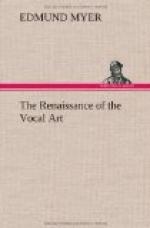to impress upon his audience. Let the singer recite
or read aloud the words of his songs. This is
a natural form of expression, and requires a less
complex process of thought than singing, which demands
several automatic reflexes in securing tone production;
let him read aloud, trying to give out every shade
of thought and feeling the poem contains, in a tone
which is persuasive and appealing. Later, when
he can do this with appropriate emphasis in speech,
let him try to express the same meanings in his singing
voice. In all probability he will find that he
is much assisted by the music, if his tone production
is reasonably correct and authoritative, and he be
enough of a musician to grasp readily tonal values.
The sense of the words, the emotion and thought underlying
the words, will suggest the color and character of
voice appropriate to the expression and interpretation
of the song as a whole. Of course, if he tries
to impress upon his hearer that he thinks it rather
weak and foolish to give up completely to the full
significance of the words, and to impersonate their
narrative or dramatic significance, there is no help
for him. I am inclined to think that the fear
of seeming exuberant or foolish, the unwillingness
to give one’s inner self to others, or a self-consciousness
which prevents it, is at the root of much apparent
lack of “temperament.” The singer
must be both the narrator of the story of the poem
and the impersonator of the principal characters in
that story. Upon the completeness of his understanding
of the meaning of the poem, and his revelation of
its meanings, as well as upon the absence of stiffness
or self-consciousness in suggesting the moods or characteristics
displayed, will depend the impression of temperamental
force upon his audience.
The following suggestions may be of some value as
devices in making songs mean something; and this,
after all, is the object of all attempts at interpretation.
Suppose you take a new song—one you have
never seen before. Do not sit at the pianoforte,
and play at it and sing at it until, after a fashion,
you know it. This way of learning leads to the
kind of statement recently heard after a peculiarly
bad performance, “Why, I never think of the words
at all when I sing!” Instead of doing this,
if you have been taught to do so, read the song through,
observing its general character. If thinking music
without playing or singing be impossible for you, play
it over, carefully noting tempo and other general
characteristics, until you have an understanding of
the melody, rhythm, and musical content. Observe
how the words fit the music, still without singing.
Then read the poem silently and carefully, and decide
whether it is narrative, lyric, dramatic, churchly,
or in other ways distinctive. Next read the poem
aloud, giving the voice character appropriate to its
sentiment, phrasing it intelligibly, observing the
emotional portent, and coloring it accordingly.




